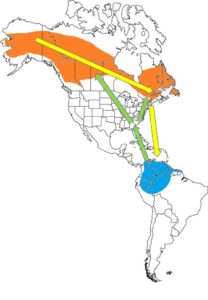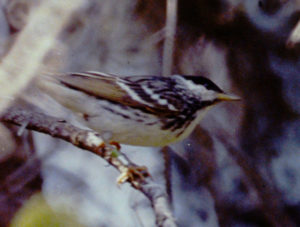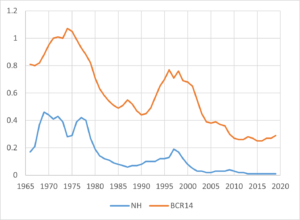(by Pam Hunt)
If you’re inclined to hike in the high-elevation spruce-fir forests in the White Mountains, chances are you’ve at least heard a Blackpoll Warbler (unless you’ve also lost your high-frequency hearing). Along with juncos and White-throated Sparrows, this warbler is one of the most common birds in this habitat, and unlike other high-elevation specialists like Bicknell’s Thrush it can be found on more isolated southerly mountains such as Cardigan and (formerly) Kearsage. Farther north it also breeds in lowland spruce forest, where its range extends from the Bering Sea in Alaska across the vast Canadian taiga to Newfoundland. An estimated population of 60 million birds make the Blackpoll one of the most abundant birds in North America.

Its abundance and wide range, however, are not what makes the Blackpoll Warbler (Setophaga striata) stand out. For that we need to turn to the species’ migration route (Figure 1). Each fall most of those 60 million Blackpolls head south and east towards the area from North Carolina to Nova Scotia, where they will stop to rest and feed for up to two weeks. When they arrive they weigh less than half an ounce (about the same as 10 paper clips), but can almost double this weight by feeding on berries and insects. With these extra stores of energy-rich fat, they wait for a northwest wind and head out over the North Atlantic. Unless they die on route (and many do) their next landfall is either the islands of the eastern Caribbean or the north coast of South America. To get there they may travel non-stop for up to 80 hours and 2000 miles and have usually burned through all that fat in the process. Physiologically this is a feat that we mere mammals can barely comprehend, let alone achieve.
After wintering in South America, Blackpolls have a much easier route in spring. They make a shorter water crossing over the western Caribbean to land in Florida or along the gulf coast and then spread out to work their way back to their breeding grounds over land. Add all this together and the birds that breed in Alaska have one of the longest migrations (potentially 13,000 miles) of any North American songbird.
To bring all this back closer to home, on May 29, a Blackpoll was detected by the new Motus station at NH Audubon’s Massabesic Center. It was tagged in central Columbia on April 11, and next detected in Delaware on May 27. In the next two days it traveled 360 miles – entirely at night – and for all we know it covered that distance in one jump: 360 miles in a day is nothing to a bird that can cover 2000 in three! Data from other Blackpolls tagged in Columbia all show a similar route. Most first appear in the southeast and then follow the coast north and east, indicating they are from the eastern end of the breeding range. Presumably even more take the westward route shown in Figure 1, but there are fewer Motus towers there to detect them. Take a moment to put this single bird in perspective. It flew south over the ocean in the fall of 2021, spent the winter in South America, and flew back in the spring of 2022. If it was more than a year old when it headed south, it may have made this journey two or even three times now – not bad for a bird weighing the same as 10 paper clips.


Migration is a dangerous time, and migratory species are more likely to be declining than sedentary ones. The Blackpoll Warbler is no exception, and although data from the Northeast are somewhat sparse (Figure 2), the consensus is that Blackpolls are at best stable, and at worst only half as common as they were 50 years ago. Because most of them breed in remote northern forests the possible causes of the decline are largely unknown. Here in the Northeast we wonder about the effects of climate change on cold-adapted montane forests, which may slowly shift uphill and thus offer less habitat to the birds that live in them. Climate change may also result in increased mortality during migration due to increased storms, unseasonal cold snaps, or other perturbations of long-term weather patterns.
There’s clearly a lot left to learn about the Blackpoll Warbler, but it’s exciting to see that NH Audubon has already played its own small part in increasing our knowledge of its migration. We also monitor breeding numbers on Cannon Mountain (which might be increasing) each June as part of a cooperative project with NH Fish and Game and Franconia Notch State Park. As data such as these accumulate over time, here’s hoping we can determine how best to conserve Blackpoll Warblers and their marathon migrations – and keep hearing them in the beautiful mountain forests of New Hampshire.
State of the Birds at a Glance:
- Habitat: Spruce-fir forest
- Migration: Long-distance
- Population trend: Declining
- Threats: Habitat loss, climate change, collisions
- Conservation actions: Work to minimize impacts of climate change, make windows and buildings safer for birds
More information on “The State of New Hampshire’s Birds” is available at: https://www.nhaudubon.org/conservation/the-state-of-the-birds/
